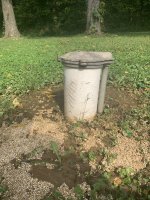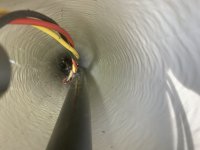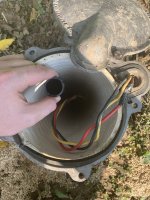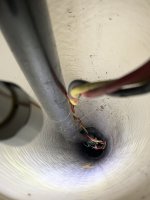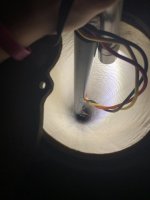A few days back I noticed a considerable amount of standing water around the casing of our well pump out behind the house. I immediately called our local plumbing company and shut off the switch to the pump. Over the past probably 5 days, we’ve been using as little water as possible and only switching the pump back on to do dishes, shower, ect. I always shut it off promptly afterwards, but I forgot to tonight and it was about 2 hours before I remembered. After I had turned it off, I went out to the well and while it wasn’t terribly wet around it, I noticed there was foam beads that had come from the ground and was around the well pump casing. Probably a good couple hands fulls worth. Any ideas on what this is from?
You are using an out of date browser. It may not display this or other websites correctly.
You should upgrade or use an alternative browser.
You should upgrade or use an alternative browser.
Foam Around Well Casing
- Thread starter Caleb M
- Start date
Users who are viewing this thread
Total: 2 (members: 0, guests: 2)
You probably have a leak at the pitless adapter and water is spewing up and foaming from there.
Sponsor
Paid Advertisement
It’s not foam like that. It’s like little styrofoam beads. I have a concern that it could be insulation from something like the foundation.You probably have a leak at the pitless adapter and water is spewing up and foaming from there.
Still probably have a leak outside the well that is spraying into something like insulation.
I had been picturing like the stuffing of a bean bag chair.You probably have a leak at the pitless adapter and water is spewing up and foaming from there.
Is it a major concern and what would you have to guess for the cost of the repair?Still probably have a leak outside the well that is spraying into something like insulation.
Let's see a photo of your well cap and the ground beneath. Your casing extends what -- 10 inches above ground level?
If you lift the well cap, you should be able to see the top of the pitless adapter. That will let you determine how much digging depth will be involved.
If you lift the well cap, you should be able to see the top of the pitless adapter. That will let you determine how much digging depth will be involved.
Also see if you are losing pressure when no water is being used.
My parents left me this house and we also need a pressure tank. The old one was taken out and a new one was never put in. I have some pictures of what’s going on. The ground is a little wet in the photos bc I just flipped the switch back on and flushed the toilet.
Attachments
Caleb, after flushing the toilet and turning off the power to the pump, what happened to the pressure gauge indication?Also see if you are losing pressure when no water is being used.
On your picture down the well, is this taken with the camera above ground, or down below the pitless?
If above the pitless, what does the top of that black pipe look like?
How far down is the pitless adapter?
The pressure returns to 0 after I shut the switch to the pump back off.Caleb, after flushing the toilet and turning off the power to the pump, what happened to the pressure gauge indication?
On your picture down the well, is this taken with the camera above ground, or down below the pitless?
If above the pitless, what does the top of that black pipe look like?
How far down is the pitless adapter?
The picture is taken above ground right inside the well casing.
I don’t see a pitiless adapter when I look into the well.
im sorry if I’m not being of much help here, I’m only 19 and didn’t know jack squat about well systems before any of this.
Attachments
Can see down 5 ft below ground level? If it is too dark use a bright flashlight at night, or reflect the sun down the well during the bright day. Water gets to the house somehow. That is how we infer a pitless adapter. A pitless is unlikely to be more than 4 ft below ground level.
If you stick an electrical snake down that pipe or a tape measure, will that go down more than 6 ft? I would hope a tape measure would not snag its hook. Maybe some other probe is a good idea. Don't drop anything down the pipe or the casing.
So why does this matter? Sanity check, but also the depth of the pitless is how far down somebody is going to have to dig to fix the leak. If you do the digging, you could save some money probably. I have a theory as to what that poly pipe is doing there, but lets get the pitless info first.
Having the well service do this means its done quickly.
If you stick an electrical snake down that pipe or a tape measure, will that go down more than 6 ft? I would hope a tape measure would not snag its hook. Maybe some other probe is a good idea. Don't drop anything down the pipe or the casing.
So why does this matter? Sanity check, but also the depth of the pitless is how far down somebody is going to have to dig to fix the leak. If you do the digging, you could save some money probably. I have a theory as to what that poly pipe is doing there, but lets get the pitless info first.
Having the well service do this means its done quickly.
Can see down 5 ft below ground level? If it is too dark use a bright flashlight at night, or reflect the sun down the well during the bright day. Water gets to the house somehow. That is how we infer a pitless adapter. A pitless is unlikely to be more than 4 ft below ground level.
If you stick an electrical snake down that pipe or a tape measure, will that go down more than 6 ft? I would hope a tape measure would not snag its hook. Maybe some other probe is a good idea. Don't drop anything down the pipe or the casing.
So why does this matter? Sanity check, but also the depth of the pitless is how far down somebody is going to have to dig to fix the leak. If you do the digging, you could save some money probably. I have a theory as to what that poly pipe is doing there, but lets get the pitless info first.
Having the well service do this means its done quickly.
Alright the pitiless is about 4.5 ft. down. Here’s a pic
Attachments
From the top of the casing? If so, then if the casing stands 1 ft above the ground, whoever digs will have to dig down 3.5 feet, and give enough space for a repair. Feel like digging? Maybe start, and that will inspire you to pay somebody to dig for you.Alright the pitiless is about 4.5 ft. down.
Is that pipe up top gray or black. In your earlier photos it looked like black polyethylene.
In this one, it looked like maybe gray PVC.
I suspect you have a trapezoidal pitless. There are various units, and don't presume the two parts or the o-ring inside or out are interchangeable.
This seems to describe things pretty well: https://blog.boshart.com/accurately-installing-a-slide-pitless-adapter
When you dig, we expect to see some flaw like the pipe came off of the adapter outside of the pitless adapter.
You are looking in the right area. Like Reach says the problem is outside the casing. Might as well start digging. Be careful of the wire. But when you shut off the pump and the pressure goes to zero even when no water is being used, water is leaking somewhere.
From the top of the casing? If so, then if the casing stands 1 ft above the ground, whoever digs will have to dig down 3.5 feet, and give enough space for a repair. Feel like digging? Maybe start, and that will inspire you to pay somebody to dig for you.
Is that pipe up top gray or black. In your earlier photos it looked like black polyethylene.
In this one, it looked like maybe gray PVC.
I suspect you have a trapezoidal pitless. There are various units, and don't presume the two parts or the o-ring inside or out are interchangeable.
This seems to describe things pretty well: https://blog.boshart.com/accurately-installing-a-slide-pitless-adapter
When you dig, we expect to see some flaw like the pipe came off of the adapter outside of the pitless adapter.
Thank you guys! I’m going to have someone come out and dig it up. Also the pipe is some type of black polyethylene. I think it is used to pull up the well pump.
Wise move.Thank you guys! I’m going to have someone come out and dig it up.
Normally the pitless, and thus the pump are pulled up by a t-handled pipe that has a 1 inch NTP thread. The T-handle both gives a place to hold or lash onto, but it also prevents the assembly from falling down the well.Also the pipe is some type of black polyethylene. I think it is used to pull up the well pump.
So was that poly pipe formerly part of a T-handle? And then was it cut to allow placement of the well cap because they could not unscrew it as planed?
Or is it there as a placeholder to keep stuff out of the female thread at the top of the pitless. I would lean that way, and I would hope that is the case. Galvanized or black pipe is good for making the T-handle lifting tool.
Well the plumbing company never came out after a week of constantly calling and trying to get ahold of them. Dug it up myself and this is what I’ve found. Not what I was expecting. It seems to be a pressure tank buried 4.5 ft. underground. I assumed we didn’t have a pressure tank bc the gauge inside never held pressure. Still haven’t found the leak.
Attachments
Underground pressure tank. Saves indoor space. The pressure switch should normally be near the pressure tank. That requires special consideration. I think there is normally a way to check and change the air precharge pressure.
That is the casing on the left? Close. When you turn on the well power for a bit, which way does the water come from? Since you have un-buried the pitless connection at the casing, you could tell. In fact, maybe digging out more dirt below the pitless would be good before test would be good.
The Well-X-Trol UG (underground) tanks I think have their water connections on the bottom. I wonder if the leak is the buried pressure tank. Seems likely. If the water rises from below, that's it.
This may be a good application for the Cycle Stop Psidekick.
https://cyclestopvalves.com/collections/frontpage/products/custom-pk1a-pside-kick-kit
As long as the pump does not generate too much pressure for the poly, that could go indoors without taking a lot of space. You would just splice the poly around that buried tank, and move the pressure switch indoors. Do you see markings on the black poly?
Your search term would be CSV except the search box above does not let you search for 3-character words. Try csv* instead.
Regarding the foam balls, that may have been put there to make for easier digging if/when the tank needs replacing. I think sand is sometimes used for that.
That is the casing on the left? Close. When you turn on the well power for a bit, which way does the water come from? Since you have un-buried the pitless connection at the casing, you could tell. In fact, maybe digging out more dirt below the pitless would be good before test would be good.
The Well-X-Trol UG (underground) tanks I think have their water connections on the bottom. I wonder if the leak is the buried pressure tank. Seems likely. If the water rises from below, that's it.
This may be a good application for the Cycle Stop Psidekick.
https://cyclestopvalves.com/collections/frontpage/products/custom-pk1a-pside-kick-kit
As long as the pump does not generate too much pressure for the poly, that could go indoors without taking a lot of space. You would just splice the poly around that buried tank, and move the pressure switch indoors. Do you see markings on the black poly?
Your search term would be CSV except the search box above does not let you search for 3-character words. Try csv* instead.
Regarding the foam balls, that may have been put there to make for easier digging if/when the tank needs replacing. I think sand is sometimes used for that.
Last edited:
Looks like that tank was installed upside down. That is ok, just means the connection is the one on the top that you can see. Turn on the water and see where it is leaking. Either way disconnecting that underground tank is needed, and as was said a PK1A kit would be a good replacement for that system and would take up much less space and could be installed further away in the house or something.

https://cyclestopvalves.com/pages/pk1a-pside-kick
https://cyclestopvalves.com/pages/pk1a-pside-kick
Similar threads
- Replies
- 12
- Views
- 219
- Replies
- 2
- Views
- 189
- Replies
- 2
- Views
- 410
- Replies
- 5
- Views
- 114


